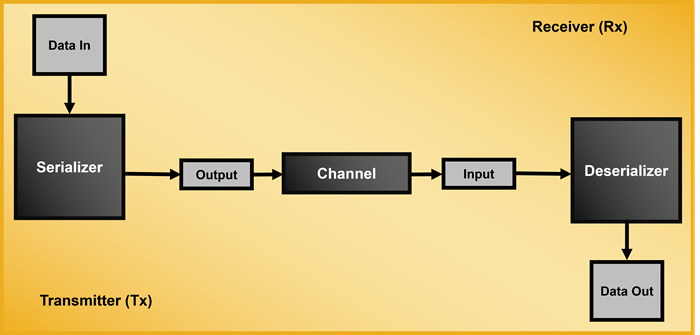Serializer Deserializer (SERDES) is an electronic circuit designed to transform serial data into parallel data and vice versa, most commonly found in high-speed communications applications.
SERDES mainly consists of two parts:
- Serializer: A serializer is responsible for converting parallel data into serial data. It receives data in the form of parallel bits and converts them into a stream of serial bits that can be transmitted over a communication channel.
- Deserializer: A deserializer is responsible for converting serial data into parallel data. It receives the serial data and converts it back into parallel bits that can be used by the receiving system.
SERDES technology includes a transmitter (TX) block, which serializes the parallel data, and a receiver (RX) block, which deserializes the serial data back into parallel form. In addition, SERDES circuits often include clock and data recovery (CDR) circuits, equalizers, data alignment, and error detection and correction mechanisms to ensure accurate and reliable data transmission over a communication channel.

Illustrative block diagram of a SERDES circuit
What are the Key Benefits of SERDES?
SERDES serial I/O technology enables data transmission across a channel (PCB, cable) at rates that can exceed 2000 - 3000 times faster than what can be achieved with parallel transmission techniques. Parallel techniques send data across several signal wires with a very carefully aligned clock to synchronize the transmitter and receiver. The challenge is balancing the exact wire length for accurate data and clock signal capture on receiving end. If there are very small changes in PCB trace, cable wire length or noisy electrical interference, the data captured on the receiving end will be prone to error and can be unreliable.
The magic of SERDES technology happens by combining the clock and data into a single signal at the transmitter and using Clock and Data Recovery (CDR) techniques to capture the data on the receiving end without errors at the SERDES receiver. CDR circuits are finely tuned analog / digital circuits that allow SERDES to operate in the many Gigabits per second range.
SERDES can reduce the intricacy, cost, and usage linked with applying wide parallel data buses when moving large amounts of data. It is specifically beneficial when frequency rates of parallel data move past 500 MHz.
SERDES also allow significant savings in the number of I/O required to move large amounts of data across a channel compared to parallel techniques. Reducing I/O saves on cost and board area.
SERDES is often used in communication systems such as Peripheral Component Interconnect Express (aka PCI Express® or PCIe®) and Ethernet wherein high data rates are required over a limited number of wires. It is also the most essential building block for chip-to-chip interconnect systems.
What is SERDES in FPGA?
SERDES is a critical component in some FPGA designs as it provides high speed communication between various devices or systems. Since SERDES converts parallel data into serial data, and vice versa, it allows large quantities of data to be transmitted at high speeds, all at reduced power consumption and lower EMI emissions.
FPGAs use SERDES technology to transfer data over high-speed serial communication links, which can operate at rates of several gigabits per second. These links can be used to communicate with external devices, such as other FPGAs, CPUs, memories, or network interfaces.
Common Uses of SERDES in FPGAs
- High-speed Data Transmission
SERDES technology is utilized to transmit high-speed data between FPGAs or between FPGAs and other parts of system like memory, processors, and network interfaces. This is commonly used in systems designed for datacenters, telecommunications, and high-performance computing.
The Lattice Avant™ 16nm FinFET platform features 25 Gb/s SERDES addressing a wide variety of applications including high-speed data transmission.
- Optical Communications and Networking Applications
SERDES technology is an essential component for the implementation of many communications protocols such as PCIe and Ethernet. PCIe was designed to handle growing bandwidth needs through a scalable, point-to-point serial connection between chips using cables or connector slots for expansion cards. It also ensures software compatibility with traditional Peripheral Component Interconnect (PCI).
Lattice CertusPro™-NX FPGAs support 10G SERDES which support up to PCIe Gen 3 and 10G Ethernet.
- Video and Audio Processing
FPGAs with SERDES technology are often used in video and audio processing applications, where they can manage high-speed data streams and carry out tasks such as video decoding, encoding, and compression.
Lattice CrossLink™-NX FPGAs have embedded MIPI D-PHY interfaces (CSI and DSI). This protocol is an industry standard and relies on SERDES technology.
- Industrial Automation and Robotics
By utilizing industrial networking protocols, modules can communicate with each other seamlessly. FPGAs take a role in three main industrial applications including real-time processing, advanced control, and electronic instrumentation.
CertusPro-NX Versa Board helps designers to evaluate designs specific to industrial market and provide engineers with a platform for prototyping and testing.
- Automotive Applications
Modern cars use a variety of sensors and cameras to support their ADAS capabilities, which collect data that needs to be pre-processed to remove noise and format it properly.
While certain cameras and sensors adhere to the MIPI standards, others employ high-speed SERDES to facilitate longer distance connections. Check how Lattice FPGAs addresses next-generation cars requiring a higher level of performance.
SERDES Enhanced FPGAs
Through the combination of high-speed serial data transceivers and programmable logic, SERDES enhanced FPGAs provide significant flexibility and architectural freedom. This enables system designers to implement application features and performance unmatched by any other technologies. Furthermore, FPGAs enable rapid development cycles as well programmability that allows for accommodation of evolving system standards. As a low power programmable leader, Lattice offers SERDES enhanced FPGAs to help your design reach its full potential.
Lattice FPGAs with SERDES Technology

ECP5 / ECP5-5G - Break the rules of power, size and cost in your connectivity and acceleration applications
For information about other Lattice FPGAs, visit our Products page here.